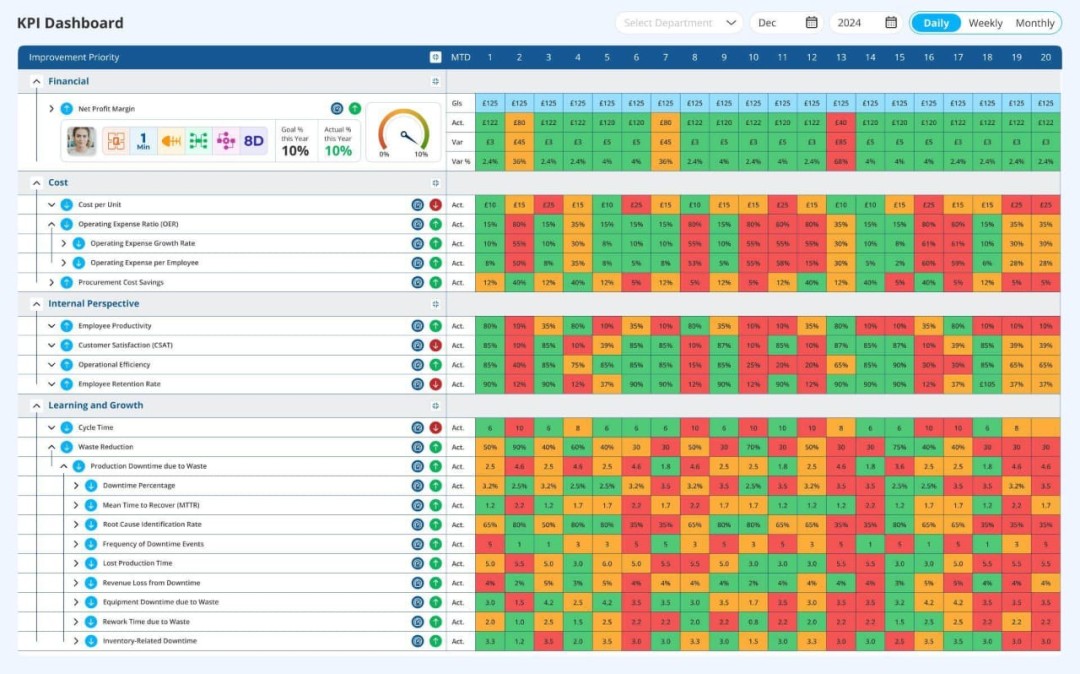
For years, organisations have struggled with a familiar contradiction. Strategy is defined at the top, but execution is scattered across departments, spreadsheets and disconnected reporting cycles. The balance between long-term planning and daily operational decisions has always been fragile. Recent global disruptions have widened that gap and forced leaders to rethink how strategy is managed altogether.
According to research, as many as 90% of organisations fail to execute their strategies successfully, even when the strategy is sound.
That reality has renewed attention on the Balanced Scorecard – the strategic management framework that links financial, customer, internal-process, and learning (FCIL) perspectives. What began as a way to make strategy more measurable has evolved into a model for continuous, real-time execution. Leadership teams are now demanding systems that keep those four perspectives alive, visible and aligned, not just once a quarter but every day.
The New Era of Strategy Execution Is Here
Across industries, one shift is becoming impossible to ignore. Leaders are moving away from monthly reporting and static KPI tracking toward a model of continuous, real-time strategy execution. This transformation didn’t happen overnight. It grew out of pressures that exposed long-standing weaknesses in how organisations monitor goals, measure performance and stay aligned.
The early 2000s were defined by Excel-driven reporting. By the 2010s, organisations were managing strategy through a patchwork of slide decks, emails and manual scorecards. These tools worked in stable conditions, but they were never built for fast-changing environments. When COVID-19 disrupted global supply chains, workforces and customer behaviour, the flaws became impossible to overlook. Leaders couldn’t wait for end-of-month updates to respond. They needed clarity in the moment.
Why Traditional KPI Management Failed
The shortcomings were visible everywhere: KPIs managed in isolation, delayed reporting cycles and strategies that sat in presentations rather than influencing daily decisions. As uncertainty grew, so did the cost of slow information flow. Projects drifted, teams worked toward different priorities and organisations lacked a reliable way to see whether their decisions were moving them closer to their goals.
Many companies discovered the same systemic problem — strategy was static, but the world was not.
The Balanced Scorecard Returns to the Centre
This environment has renewed interest in the Balanced Scorecard, a framework introduced in the 1990s to align financial, customer, internal process and learning objectives. What began as a paper-based tool for strategic planning has now re-emerged as the backbone of modern performance management. Its core strength is connecting objectives to measurable performance — fits today’s demand for transparency and alignment.
With platforms like LTS Data Point Balanced Scorecard software, organisations are retiring traditional scorecard templates in favour of digital, always-on systems that keep strategy visible at every level. The evolution mirrors the broader transition from analogue to digital to real-time business operations.
When Strategy Moves in Real Time
The rise of digital strategy execution platforms marks a turning point. Instead of waiting for scheduled reviews, organisations now track performance as it unfolds. Leaders gain immediate insight into which initiatives are on course and which require course correction. Teams can see how their daily actions contribute to broader outcomes, improving ownership and accountability.
LTS Data Point Balanced Scorecard is chosen by many industry leaders due to its ability to bring line-of-sight mapping, live KPI tracking and flowchart-based strategy visualisation into one connected environment. These tools reflect how real-time strategy execution is becoming standard rather than optional.
A Changing Leadership Model
This shift changes how leaders think and operate. Meetings are no longer spent organising data; they are spent solving problems. Strategy is not reviewed — it is managed. The ability to adjust priorities instantly, respond to market movements and engage teams in transparent performance conversations is becoming a competitive advantage.
Organisations adopting real-time strategy execution report fewer delays, faster decision cycles and more consistent alignment between departments. In sectors where conditions change weekly or even daily, the benefits are even stronger.
Looking Ahead: What This Means for Organisations
As more companies prioritise resilience, agility and connected performance, the movement toward real-time strategy management will accelerate. The world is too fast and too complex for static tools and disconnected reporting. Organisations that embed strategy into the rhythm of daily work will outpace those that rely on traditional methods.
The Balanced Scorecard framework, strengthened by digital transformation, is positioned to play a defining role in how organisations navigate this next era. What began as a planning tool is now emerging as a central mechanism for continuous execution, alignment and performance visibility.
Media Contact
Company Name: Lean Transition Solutions (LTS)
Contact Person: Brett Griffiths
Email: Send Email
Address:The Old Vicarage, Pershore Road, Upton Snodsbury
City: Worcester
State: Worcestershire
Country: United Kingdom
Website: https://leandatapoint.com/
